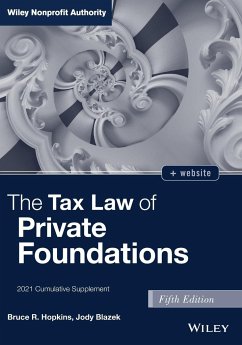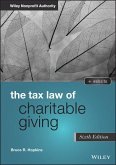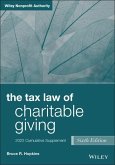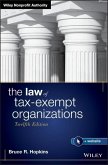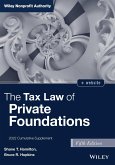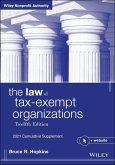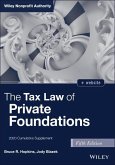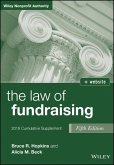- Broschiertes Buch
- Merkliste
- Auf die Merkliste
- Bewerten Bewerten
- Teilen
- Produkt teilen
- Produkterinnerung
- Produkterinnerung
The Tax Law of Private Foundations, 2021 Cumulative Supplement, 5th Edition
Andere Kunden interessierten sich auch für
![The Tax Law of Charitable Giving The Tax Law of Charitable Giving]() Bruce R. HopkinsThe Tax Law of Charitable Giving274,99 €
Bruce R. HopkinsThe Tax Law of Charitable Giving274,99 €![The Tax Law of Charitable Giving The Tax Law of Charitable Giving]() Bruce R. HopkinsThe Tax Law of Charitable Giving149,99 €
Bruce R. HopkinsThe Tax Law of Charitable Giving149,99 €![The Law of Tax-Exempt Organizations The Law of Tax-Exempt Organizations]() Bruce R. HopkinsThe Law of Tax-Exempt Organizations300,99 €
Bruce R. HopkinsThe Law of Tax-Exempt Organizations300,99 €![The Tax Law of Private Foundations The Tax Law of Private Foundations]() Bruce R. HopkinsThe Tax Law of Private Foundations138,99 €
Bruce R. HopkinsThe Tax Law of Private Foundations138,99 €![The Law of Tax-Exempt Organizations, + Website The Law of Tax-Exempt Organizations, + Website]() Bruce R. HopkinsThe Law of Tax-Exempt Organizations, + Website223,99 €
Bruce R. HopkinsThe Law of Tax-Exempt Organizations, + Website223,99 €![The Tax Law of Private Foundations The Tax Law of Private Foundations]() Bruce R. HopkinsThe Tax Law of Private Foundations140,99 €
Bruce R. HopkinsThe Tax Law of Private Foundations140,99 €![The Law of Fundraising The Law of Fundraising]() Bruce R. HopkinsThe Law of Fundraising178,99 €
Bruce R. HopkinsThe Law of Fundraising178,99 €-
-
-
Produktdetails
- Produktdetails
- Verlag: Wiley / Wiley & Sons
- Artikelnr. des Verlages: 1W119804330
- 5. Aufl.
- Seitenzahl: 224
- Erscheinungstermin: 9. November 2021
- Englisch
- Abmessung: 254mm x 178mm x 12mm
- Gewicht: 432g
- ISBN-13: 9781119804338
- ISBN-10: 1119804337
- Artikelnr.: 61394796
- Herstellerkennzeichnung
- Libri GmbH
- Europaallee 1
- 36244 Bad Hersfeld
- gpsr@libri.de
- Verlag: Wiley / Wiley & Sons
- Artikelnr. des Verlages: 1W119804330
- 5. Aufl.
- Seitenzahl: 224
- Erscheinungstermin: 9. November 2021
- Englisch
- Abmessung: 254mm x 178mm x 12mm
- Gewicht: 432g
- ISBN-13: 9781119804338
- ISBN-10: 1119804337
- Artikelnr.: 61394796
- Herstellerkennzeichnung
- Libri GmbH
- Europaallee 1
- 36244 Bad Hersfeld
- gpsr@libri.de
Bruce R. Hopkins concentrates on the representation of tax-exempt organizations, practicing with the Bruce R. Hopkins Law Firm, LLC, Kansas City, Missouri. He is the Professor from Practice at the University of Kansas School of Law. He writes a monthly newsletter, the Bruce R. Hopkins' Nonprofit Counsel, now in its 34th year. Hopkins is the author of over 30 books in the field of nonprofit tax law.
Preface
Book Citations
1 Introduction to Private Foundations
1.1 Private Foundations: Unique Organizations
1.2 Definition of Private Foundation
1.4 Private Foundation Law Primer
1.5 Foundations in Overall Exempt Organizations Context
1.6 Definition of Charity
1.7 Operating for Charitable Purposes
1.9 Private Foundation Sanctions
1.10 Statistical Profile
1.11 Private Foundations and Law 50 Years Later
2 Starting, Funding, and Governing a Private Foundation
2.1 Choice of Organizational Form
2.3 Estate Planning Principles
2.4 Foundations and Planned Giving
2.5 Acquiring Recognition of Tax-Exempt Status
2.6 Special Requirements for Charitable Organizations
2.7 When to Report Back to the IRS
3 Types of Private Foundations
3.1 Private Operating Foundations
3.3 Conduit Foundations
3.8 Split-Interest Trusts
3.9 Foreign Private Foundations
4 Disqualified Persons
4.1 Substantial Contributors
4.2 Foundation Managers
4.3 Certain 20 Percent Owners
4.4 Family Members
4.5 Corporations or Partnerships
4.6 Trusts or Estates
5 Self-Dealing
5.1 Private Inurement Doctrine
5.2 Private Benefit Doctrine
5.3 Definition of Self-Dealing
5.3A Excess Compensation Tax
5.4 Sale, Exchange, Lease, or Furnishing of Property
5.5 Loans and Other Extensions of Credit
5.6 Payment of Compensation
5.8 Uses of Income or Assets by Disqualified Persons
5.11 Indirect Self-Dealing
5.12 Property Held by Fiduciaries
5.14 Additional Exceptions
5.15 Issues Once Self-Dealing Occurs
6 Mandatory Distributions
6.1 Distribution Requirements--in General
6.2 Assets Used to Calculate Minimum Investment Return
6.3 Determining Fair Market Value
6.5 Qualifying Distributions
7 Excess Business Holdings
7.1 General Rules
7.2 Permitted and Excess Holdings
7.3 Functionally Related Businesses
7.7 Excise Taxes on Excess Holdings
8 Jeopardizing Investments
8.2 Prudent Investments
8.3 Program-Related Investments
9 Taxable Expenditures
9.1 Legislative Activities
9.2 Political Campaign Activities
9.3 Grants to Individuals
9.4 Grants to Public Charities
9.5A Funding of Employee Hardship Programs
9.6 Grants to Foreign Organizations
9.8 Internet and Private Foundations
9.9 Spending for Noncharitable Purposes
9.10A Distributions to Group Exemption Organizations
9.11 Excise Tax for Taxable Expenditures
10 Tax on Investment Income
10.1 Rate of Tax
10.3 Formula for Taxable Income
10.5 Foreign Foundations
11 Unrelated Business Activity
11.1 General Rules
11.2 Exceptions
11.3 Rules Specifically Applicable to Private Foundations
11.4 Unrelated Debt-Financed Income Rules
11.5 Calculating and Reporting the Tax
12 Tax Compliance and Administrative Issues
13 Termination of Foundation Status
13.1 Voluntary Termination
13.3 Transfer of Assets to a Public Charity
13.4 Operation as a Public Charity
13.6 Termination Tax<
Book Citations
1 Introduction to Private Foundations
1.1 Private Foundations: Unique Organizations
1.2 Definition of Private Foundation
1.4 Private Foundation Law Primer
1.5 Foundations in Overall Exempt Organizations Context
1.6 Definition of Charity
1.7 Operating for Charitable Purposes
1.9 Private Foundation Sanctions
1.10 Statistical Profile
1.11 Private Foundations and Law 50 Years Later
2 Starting, Funding, and Governing a Private Foundation
2.1 Choice of Organizational Form
2.3 Estate Planning Principles
2.4 Foundations and Planned Giving
2.5 Acquiring Recognition of Tax-Exempt Status
2.6 Special Requirements for Charitable Organizations
2.7 When to Report Back to the IRS
3 Types of Private Foundations
3.1 Private Operating Foundations
3.3 Conduit Foundations
3.8 Split-Interest Trusts
3.9 Foreign Private Foundations
4 Disqualified Persons
4.1 Substantial Contributors
4.2 Foundation Managers
4.3 Certain 20 Percent Owners
4.4 Family Members
4.5 Corporations or Partnerships
4.6 Trusts or Estates
5 Self-Dealing
5.1 Private Inurement Doctrine
5.2 Private Benefit Doctrine
5.3 Definition of Self-Dealing
5.3A Excess Compensation Tax
5.4 Sale, Exchange, Lease, or Furnishing of Property
5.5 Loans and Other Extensions of Credit
5.6 Payment of Compensation
5.8 Uses of Income or Assets by Disqualified Persons
5.11 Indirect Self-Dealing
5.12 Property Held by Fiduciaries
5.14 Additional Exceptions
5.15 Issues Once Self-Dealing Occurs
6 Mandatory Distributions
6.1 Distribution Requirements--in General
6.2 Assets Used to Calculate Minimum Investment Return
6.3 Determining Fair Market Value
6.5 Qualifying Distributions
7 Excess Business Holdings
7.1 General Rules
7.2 Permitted and Excess Holdings
7.3 Functionally Related Businesses
7.7 Excise Taxes on Excess Holdings
8 Jeopardizing Investments
8.2 Prudent Investments
8.3 Program-Related Investments
9 Taxable Expenditures
9.1 Legislative Activities
9.2 Political Campaign Activities
9.3 Grants to Individuals
9.4 Grants to Public Charities
9.5A Funding of Employee Hardship Programs
9.6 Grants to Foreign Organizations
9.8 Internet and Private Foundations
9.9 Spending for Noncharitable Purposes
9.10A Distributions to Group Exemption Organizations
9.11 Excise Tax for Taxable Expenditures
10 Tax on Investment Income
10.1 Rate of Tax
10.3 Formula for Taxable Income
10.5 Foreign Foundations
11 Unrelated Business Activity
11.1 General Rules
11.2 Exceptions
11.3 Rules Specifically Applicable to Private Foundations
11.4 Unrelated Debt-Financed Income Rules
11.5 Calculating and Reporting the Tax
12 Tax Compliance and Administrative Issues
13 Termination of Foundation Status
13.1 Voluntary Termination
13.3 Transfer of Assets to a Public Charity
13.4 Operation as a Public Charity
13.6 Termination Tax<
Preface
Book Citations
1 Introduction to Private Foundations
1.1 Private Foundations: Unique Organizations
1.2 Definition of Private Foundation
1.4 Private Foundation Law Primer
1.5 Foundations in Overall Exempt Organizations Context
1.6 Definition of Charity
1.7 Operating for Charitable Purposes
1.9 Private Foundation Sanctions
1.10 Statistical Profile
1.11 Private Foundations and Law 50 Years Later
2 Starting, Funding, and Governing a Private Foundation
2.1 Choice of Organizational Form
2.3 Estate Planning Principles
2.4 Foundations and Planned Giving
2.5 Acquiring Recognition of Tax-Exempt Status
2.6 Special Requirements for Charitable Organizations
2.7 When to Report Back to the IRS
3 Types of Private Foundations
3.1 Private Operating Foundations
3.3 Conduit Foundations
3.8 Split-Interest Trusts
3.9 Foreign Private Foundations
4 Disqualified Persons
4.1 Substantial Contributors
4.2 Foundation Managers
4.3 Certain 20 Percent Owners
4.4 Family Members
4.5 Corporations or Partnerships
4.6 Trusts or Estates
5 Self-Dealing
5.1 Private Inurement Doctrine
5.2 Private Benefit Doctrine
5.3 Definition of Self-Dealing
5.3A Excess Compensation Tax
5.4 Sale, Exchange, Lease, or Furnishing of Property
5.5 Loans and Other Extensions of Credit
5.6 Payment of Compensation
5.8 Uses of Income or Assets by Disqualified Persons
5.11 Indirect Self-Dealing
5.12 Property Held by Fiduciaries
5.14 Additional Exceptions
5.15 Issues Once Self-Dealing Occurs
6 Mandatory Distributions
6.1 Distribution Requirements--in General
6.2 Assets Used to Calculate Minimum Investment Return
6.3 Determining Fair Market Value
6.5 Qualifying Distributions
7 Excess Business Holdings
7.1 General Rules
7.2 Permitted and Excess Holdings
7.3 Functionally Related Businesses
7.7 Excise Taxes on Excess Holdings
8 Jeopardizing Investments
8.2 Prudent Investments
8.3 Program-Related Investments
9 Taxable Expenditures
9.1 Legislative Activities
9.2 Political Campaign Activities
9.3 Grants to Individuals
9.4 Grants to Public Charities
9.5A Funding of Employee Hardship Programs
9.6 Grants to Foreign Organizations
9.8 Internet and Private Foundations
9.9 Spending for Noncharitable Purposes
9.10A Distributions to Group Exemption Organizations
9.11 Excise Tax for Taxable Expenditures
10 Tax on Investment Income
10.1 Rate of Tax
10.3 Formula for Taxable Income
10.5 Foreign Foundations
11 Unrelated Business Activity
11.1 General Rules
11.2 Exceptions
11.3 Rules Specifically Applicable to Private Foundations
11.4 Unrelated Debt-Financed Income Rules
11.5 Calculating and Reporting the Tax
12 Tax Compliance and Administrative Issues
13 Termination of Foundation Status
13.1 Voluntary Termination
13.3 Transfer of Assets to a Public Charity
13.4 Operation as a Public Charity
13.6 Termination Tax<
Book Citations
1 Introduction to Private Foundations
1.1 Private Foundations: Unique Organizations
1.2 Definition of Private Foundation
1.4 Private Foundation Law Primer
1.5 Foundations in Overall Exempt Organizations Context
1.6 Definition of Charity
1.7 Operating for Charitable Purposes
1.9 Private Foundation Sanctions
1.10 Statistical Profile
1.11 Private Foundations and Law 50 Years Later
2 Starting, Funding, and Governing a Private Foundation
2.1 Choice of Organizational Form
2.3 Estate Planning Principles
2.4 Foundations and Planned Giving
2.5 Acquiring Recognition of Tax-Exempt Status
2.6 Special Requirements for Charitable Organizations
2.7 When to Report Back to the IRS
3 Types of Private Foundations
3.1 Private Operating Foundations
3.3 Conduit Foundations
3.8 Split-Interest Trusts
3.9 Foreign Private Foundations
4 Disqualified Persons
4.1 Substantial Contributors
4.2 Foundation Managers
4.3 Certain 20 Percent Owners
4.4 Family Members
4.5 Corporations or Partnerships
4.6 Trusts or Estates
5 Self-Dealing
5.1 Private Inurement Doctrine
5.2 Private Benefit Doctrine
5.3 Definition of Self-Dealing
5.3A Excess Compensation Tax
5.4 Sale, Exchange, Lease, or Furnishing of Property
5.5 Loans and Other Extensions of Credit
5.6 Payment of Compensation
5.8 Uses of Income or Assets by Disqualified Persons
5.11 Indirect Self-Dealing
5.12 Property Held by Fiduciaries
5.14 Additional Exceptions
5.15 Issues Once Self-Dealing Occurs
6 Mandatory Distributions
6.1 Distribution Requirements--in General
6.2 Assets Used to Calculate Minimum Investment Return
6.3 Determining Fair Market Value
6.5 Qualifying Distributions
7 Excess Business Holdings
7.1 General Rules
7.2 Permitted and Excess Holdings
7.3 Functionally Related Businesses
7.7 Excise Taxes on Excess Holdings
8 Jeopardizing Investments
8.2 Prudent Investments
8.3 Program-Related Investments
9 Taxable Expenditures
9.1 Legislative Activities
9.2 Political Campaign Activities
9.3 Grants to Individuals
9.4 Grants to Public Charities
9.5A Funding of Employee Hardship Programs
9.6 Grants to Foreign Organizations
9.8 Internet and Private Foundations
9.9 Spending for Noncharitable Purposes
9.10A Distributions to Group Exemption Organizations
9.11 Excise Tax for Taxable Expenditures
10 Tax on Investment Income
10.1 Rate of Tax
10.3 Formula for Taxable Income
10.5 Foreign Foundations
11 Unrelated Business Activity
11.1 General Rules
11.2 Exceptions
11.3 Rules Specifically Applicable to Private Foundations
11.4 Unrelated Debt-Financed Income Rules
11.5 Calculating and Reporting the Tax
12 Tax Compliance and Administrative Issues
13 Termination of Foundation Status
13.1 Voluntary Termination
13.3 Transfer of Assets to a Public Charity
13.4 Operation as a Public Charity
13.6 Termination Tax<

